This story originally appeared in the Spring 2025 edition of Salmon Steward, the Pacific Salmon Foundation’s quarterly print magazine.
When rain hits the east coast of Vancouver Island, Haley Tomlin and Erik Krogh might have to pull an all-nighter — all for salmon.
“We do it in the name of science,” says Krogh, a chemistry professor and director of the Applied Environmental Research Laboratories at Vancouver Island University (VIU).
“It’s challenging, but timing is important.”
Krogh and his research counterpart Tomlin, a biologist with the BC Conservation Foundation (BCCF), collect data on a contaminant found in rubber tires that washes into salmon-bearing streams when it rains. For accuracy, they must collect samples within hours of the peak rain.
“It’s entirely weather-dependent. When the rain falls, that’s when we’re out,” Tomlin says. “It seems to always happen on the weekend at night. The rain never wants to happen at 11 a.m. on a Tuesday.”
Since 2022, Tomlin and Krogh have been monitoring 6PPD-quinone, a toxic by-product of a tire additive known as 6PPD that prevents cracking. As tires wear, this chemical builds up on roads and washes into rivers via stormwater runoff. Research from the University of Washington linked 6PPD-quinone to, ‘urban runoff mortality syndrome’ in coho salmon. Other studies suggest it also harms Chinook salmon and rainbow and steelhead trout.
VIU and BCCF aim to determine where 6PPD-quinone is present in rivers on the east coast of Vancouver Island, and at what concentrations, to determine how to best mitigate its impacts and prevent Pacific salmon die-offs.
A network of 35 volunteer stewardship groups and First Nations collect samples at nearly 200 unique sample locations at 73 streams between Victoria and Campbell River. These samples are processed using a rapid method pioneered by VIU, which allows researchers to quickly and accurately detect 6PPD-quinone in waterways.
What we’ve learned
As of November 2025, VIU has processed over 6,400 water samples, creating the largest 6PPD-quinone dataset to date.
Researchers have detected 6PPD-quinone exceeding the lethal concentration limit for juvenile coho salmon in 26 waterways on Vancouver Island. Further, researchers detected 6PPD-quinone exceeding the Province of B.C.’s 6PPD-quinone Acute Water Quality Guidelines in 36 waterways on the island.
Krogh says early findings indicate that the time of sampling is extremely important and that smaller urban streams are more affected by 6PPD-quinone than larger ones.
“This is likely because smaller creeks have weaker capacity to dilute stormwater runoff, which is especially concerning for coho salmon that rear in these habitats,” he explains.
Additionally, coho salmon are most vulnerable to 6PPD-quinone exposure in the fall, because water levels tend to be at their lowest at the end of the summer, increasing the concentration of any toxic chemicals. This is exacerbated by drought and climate change. When rain finally arrives, built-up 6PPD-quinone on the streets washes into local waterways.
“Climate change influences when 6PPD-quinone appears in streams,” says Krogh. “To mitigate its effects on Vancouver Island, we should focus on stormwater management, especially in small urban streams during major rainfall events in October and November.”
“It’s daunting to think that these fish are living in these creeks that have a lot of pollution in them. If we can prevent this harmful toxin from entering local waterways, it’s something we should work toward,” says Tomlin
An innovative lab
A key component of this research is a rapid 6PPD-quinone sampling and analysis method developed by VIU.
This method is quicker and more efficient than conventional approaches, enabling trace analysis of 6PPD-quinone within hours or days, whereas a standard lab can take weeks or months. Results are reported in an interactive database.
In 2024, the Pacific Salmon Foundation (PSF) provided $100,000 to VIU to support the purchase of a second mass spectrometer, a vital tool for identifying and measuring 6PPD-quinone.
“This spectrometer essentially doubled our capacity,” says Angelina Jaeger, a M.Sc. student at VIU. “With two spectrometers, we can easily run 100 samples per day.”
The acquisition of a second mass spectrometer has also enabled the team to measure 6PPD-quinone directly in a stream for the first time. With two instruments, one can remain at the lab to process samples while the other is mounted in their mobile lab, which is parked streamside during a rainfall event to collect continuous, real-time data. This provides unique insights into how quickly 6PPD-quinone appears in waterways and how long it persists.
“This is really critical for fish because they will be negatively affected if there is a high concentration for an extended period of time,” says Jaeger
Green solutions
Green infrastructure like rain gardens can help filter 6PPD-quinone before it reaches salmon habitat. A study from the University of British Columbia found that rain gardens can remove more than 90 per cent of 6PPD-quinone from stormwater.
More than monitoring
VIU and BCCF have hosted two workshops in Nanaimo in 2024 and 2025, bringing together researchers and practitioners to collaborate on understanding the distribution of 6PPD-quinone and discuss current remediation strategies. To help expand attendance, PSF provided travel subsidies for First Nations groups and environmental and stewardship organizations. The third and final workshop will be hosted in February 2026.
Also in 2024, PSF joined Raincoast Conservation Foundation, Watershed Watch Salmon Society, and Ecojustice in formally requesting that Environment and Climate Change Canada investigate the toxicity of 6PPD. In response, the federal government committed to prioritizing an environmental assessment of the chemical — an important first step toward regulating this harmful tire additive.
PSF remains committed to supporting efforts that protect salmon in urban waterways and identifying science-based solutions that reduce the impacts of 6PPD-quinone on wild salmon.


